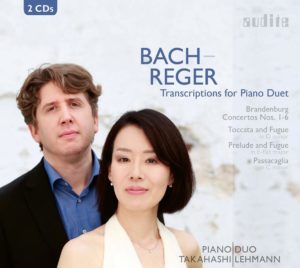Although Max Reger most likely intended his four-hand Brandenburg Concerto arrangements for home use, the thickly textured writing generally lies beyond the grasp of the average pianist. I should know, having struggled mightily to merely sight-read through them in college! At least two piano duos recorded the Bach/Reger Brandenburgs complete. First was the Berkofsky/Hagan duo for Musical Heritage Society in the 1970s (never transferred to CD, to the best of my knowledge), followed in 2001 by Teresa and Fillipo Trevisan for the small Velut Luna label. In every way these contenders yield to the Takahashi/Lehmann duo’s ensemble proficiency and musical insights.
These pianists wisely adjust Reger’s dynamics in order to point up the difference between Bach’s solo and tutti passages, while voicing the thick doublings for maximum transparency. As a result, one hears contrapuntal lines that get covered even in the best orchestral performances, notably in the First concerto’s outer movements and throughout No. 6. The scurrying solo violin lines in No. 4’s first movement seem to float off the printed page, while No. 5’s famous extended solo keyboard cadenza is transformed into a playful conversation.
In addition to the Brandenburgs, Norie Takahashi and Björn Lehmann offer Reger’s duet versions of three organ works: the D minor Toccata and Fugue, the C minor Passacaglia, and the great E-flat “St. Anne” Prelude and Fugue. The duo brilliantly streamlines the arrangements’ notey upholstery by virtue of brisk tempos, discreet pedaling, incisive articulation, and sheer joy in music making.
While there’s much to be said for Eleanor Bindman’s leaner, more stylistically apt four-hand Brandenburg arrangements (brilliantly recorded by herself and Jenny Lin for the Grand Piano label), Takahashi and Lehmann make the best possible case for Bach/Reger. Fine sonics, and informative yet grammatically convoluted annotations.
































